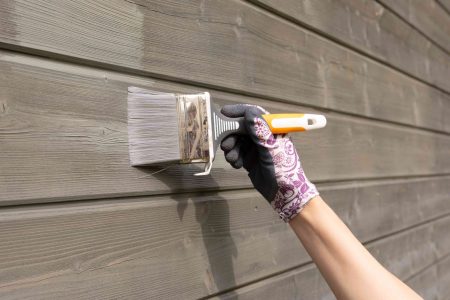Concrete can be an intimidating building material for a do-it-yourselfer. Concrete work looks as easy as pouring wet mix in a form and letting it harden. While that does describe the basics of working with concrete, any number of things can happen along the way that result in a poor concrete product. Learn tips for working with concrete that improve concrete’s strength and appearance.
Stay Safe When Working With Concrete
Nearly every material and tool used when working with concrete is heavy and cumbersome: bags of concrete, gravel, sand, mixers, wheelbarrows, and even simple implements like hoes, bull floats, and screeds. Protect your back by lifting with your legs, not your back. Keep your back straight, legs bent, and the heavy item positioned between your legs, if possible.
Concrete can cause chemical burns. So, wear proper clothing when working with concrete. Wear waterproof gloves, long sleeves, and long pants. If you need to stand in concrete, wear high rubber boots.
Choose the Correct Concrete Mix For the Project
Depending on the type of concrete project and factors like strength, setting rate, and thickness of the slab, you may need any of these concrete mixes commonly available at home centers and hardware stores.
General-Purpose Fast-Setting Concrete Mix
Good for applications 2 inches or thicker, this mix sets within 30 minutes and can be walked on after six hours. This 4,000 psi concrete mix is good for walkways, driveways, and patios.
General-Purpose High-Strength Concrete Mix
High-strength concrete mix has the same 4,000 psi strength as the fast-setting mix. It’s also good for slabs 2 inches or thicker. But you’ll need to wait a full 24 hours before walking on it. The tradeoff is that this slower setting mix is considerably less expensive than its fast-setting counterpart.
Concrete Countertop Mix
For making concrete countertops, tables, vanities, and sinks, you will need a concrete mix that’s specially blended with plasticizers and flow enhancers. Countertop concrete mix comes with these pre-blended additives and it meets the higher strength requirements (6,000 psi after 28 days of curing) for countertop work.
Concrete countertop mix also can be polished after it has dried. Concrete countertop mix is about four times more expensive than high-strength mix.
Build the Perfect Form For Your Concrete Project
Whether it’s an indoor concrete project like countertops and sinks or outdoor jobs like concrete steps, patios, floors, walkways, and shed slabs, all concrete needs a form. A form is a mold for the concrete. It shapes the sides of the concrete but not the top or the bottom.
- Build the concrete form out of scrap two-by-fours, two-by-sixes, or any width of board that matches the thickness of the slab.
- Attach the boards with screws or double-shank nails, so you’ll be able to disassemble the form later on.
- Coat the inside of the form with a commercial concrete release agent, typically a blend of chemicals that’s about 95-percent mineral oil. Or use ordinary kitchen vegetable oil.
Mix the Right Proportion of Water and Concrete Mix
Bags of pre-mixed concrete always list the water-to-mix ratio. Generally, 50 pounds of fast-setting concrete mix requires 2-1/2 to 3 quarts of water. For 50 pounds of high-strength concrete mix, use 2 to 2-1/2 quarts of water. Concrete countertop mix requires one quart of water for every 20 pounds of mix. Find the water-to-mix ratios for each type of concrete listed on the product packaging.
Another way to add the right amount of water to the concrete mix is by feel and appearance. Properly mixed concrete is often described as having a consistency like cookie dough. When you pick it up with the trowel, it forms a clump and remains on the trowel for a few moments when the trowel is angled to the side. Mix that’s too dry won’t clump properly. Mix that’s too wet slides off.
Incorporate an Admixture
Ready-mix concrete mix can be used as-is, straight out of the bag. It’s formulated to address most users’ needs. Yet it’s possible to push concrete’s parameters a bit farther with concrete admixtures.
Admixtures are added during the concrete mixing process. Depending on your needs, you can choose admixtures that slow setting time, speed it up, improve flow, add strength, or enhance the product’s ability to withstand freeze-thaw cycles.
Add Color Into the Concrete Mix
Staining cured concrete is a great way to add visual interest to an otherwise dull, gray material. But if you’re pouring concrete and already know that you’ll want color, add a liquid color to the mix.
Liquid concrete color comes in a limited palette of mostly earthen colors—reds, browns, blacks. The liquid color is first added separately to water in a bucket, stirred, then blended into the dry concrete mix.
Screed Your Concrete Flat With a Screed Tool
If you’ve ever run a knife across a measuring cup of sugar or flour to flatten it, you’ve screeded. Screeding as it applies to concrete work is similar, just on a larger scale. Screeding strikes the edges of the concrete—that is, removes excess—and generally levels out the concrete.
Screed the concrete after the pour but before finishing. A two-by-four is a favorite screed tool. Aluminum or magnesium screed tools are better, though. Unlike two-by-fours, metal screed tools are perfectly straight, have sharp edges, are light-weight, and have handles for improved control.
Float Your Concrete to Perfection
Screeding is good for overall leveling of your concrete. But to fill voids, smooth out ridges, and prepare the surface for hand-troweling, you’ll need to use a bull float. Floating gives the surface of your concrete a desirable creamy consistency by pushing down the coarse aggregate.
Ranging from 3 to 8 feet long, bull floats screw onto extension poles. Floats are pushed and pulled across the surface of the concrete while the user stands to the side.
When pushing out the bull float, slightly tip down the handle to raise the float’s nose just a bit. This prevents the nose from digging into the concrete. When pulling the float back, do the opposite: Slightly tilt the handle up to prevent the float from scraping off the concrete.
Cut Control Joints to Reduce Cracking
What Are Control Joints?
Control joints are cut into the concrete while the concrete is still plastic to minimize crack visibility both as the concrete dries, shrinks, and cools down and over the long-term life of the concrete.
Cutting into your freshly poured concrete slab is an idea that can be hard to accept. But doing so is a smart strategy that reduces or eliminates visible cracks.
Since concrete is prone to cracking, control joints control where those cracks will happen. Control joints create predictably weakened lines that encourage the concrete to crack in a predetermined straight line rather than randomly and in jagged patterns. If a crack does occur, the crack runs below the control joint, where it’s not visible from above.
On walkways, space transverse (sideways) control joints at distances equal to the walkway width. So, for a 30-inch wide path, space control joints every 30 inches.
As for depth, tool the joints in the wet concrete down to one-quarter of the slab’s thickness. Slabs for sidewalks and path are usually 4 inches thick, so tool the control joints 1-inch deep.
Keep Concrete Damp After Finishing
The concrete isn’t done after it’s finished. It still needs to cure, and you can help. If water evaporates too quickly from the concrete, the concrete will be weak. So, keep concrete moist during the curing process for maximum strength.
Lightly spray your newly poured concrete once every couple of hours for the first seven days or so. Spray more often if the water appears to be evaporating too quickly. Covering the concrete with plastic sheeting can reduce the frequency of spraying.
-
Is concrete work difficult?
Yes. Even small concrete projects require lifting 50-, 60-, or 80-pound bags of concrete, mixing it with a hoe in a wheelbarrow or in a mixer, pouring, and finishing the concrete—all within a relatively tight schedule. Good upper and lower body strength is required for working with concrete.
-
Can you pour concrete over dirt?
Yes, but it’s not ideal. You can pour concrete directly on dirt, as long as the dirt is perfectly stable, drains well, and does not contain organic materials that will decay. Because dirt doesn’t always have these qualities in combination, gravel and sand are usually a better base for concrete than dirt.
-
When should you finish concrete?
When you can press your thumb about 1/4-inch into the concrete, the concrete is ready for finishing. Screed the concrete before finishing it with the bull float and hand trowel.
-
Can you overwork concrete?
Yes, it’s possible to overwork concrete. Concrete needs to be finished, but too much finishing is detrimental. Overworking the concrete draws too much of the fine materials to the surface, potentially weakening the concrete.
Read the full article here














